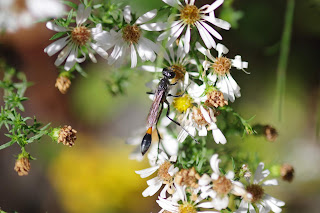Ironically, there are some bugs (which often includes butterflies) that I don't need a macro lens for, and today I actually had to go inside and switch to my telephoto lens to take pictures of the Backyard Bugs of the Day. You see, I was out in front of my house, down by the rocks near the street, looking for insects, when a huge dragonfly came along. I watched it, hoping that it would land so I could take a picture of it, but it didn't, it flew off into the trees, so I went back to taking pictures of ants and aphids as I had been doing. But then I heard a bit of a ruckus behind me, a rustling of the leaves in the street. I assumed it was an animal, as the squirrels and chipmunks have been feisty lately, but when I turned around, from among the dried leaves in the street rose what I assumed was the huge dragonfly, having turned around and come back when I wasn't looking. But there was something odd about it:
I think you can probably tell from this picture (which is horrible, but dragonflies in flight are a difficult thing to photograph), but it took me a few seconds to understand what I was seeing.
I kept trying to get a picture as the blur zoomed around...
Here's that previous picture magnified to show the Backyard Bugs of the Day:
Two dragonflies. Male and female. Flying together...
Finally they landed, but up in a tree. I took a bunch of pictures, but this was really not a situation for a macro lens. After a while I thought I might as well at least try to go inside and switch lenses in the hopes that they would still be in that same spot when I came back...
... and they were. I am sure you know what's going on here, but I can explain a bit anyway. The way dragonflies (and damselflies) mate is that the male has graspers on his back end, and he holds onto the female right behind her eyes. She moves loops her body forward to connect to the male for the transfer of his genetic material. The amount of time they spend like this varies from species to species; these two were like this for at least 10 minutes that I was watching, and eventually they flew around a bit more together before I lost them. He will stay with her, possibly connected still (I don't know about this particular species, and don't even know the name of the species), until she lays her eggs in water–I don't have any idea where they are going to do that, but there is a pond about a quarter mile down the road. Dragonfly larva live for a couple of years before they become adults, but I don't know if these will spend the coming winter as eggs or if they will hatch before then. I assume they will hatch before winter, but I guess it depends on when we have a frost.
And here are the ants and aphids I mentioned:
Notice that the aphids are different sizes/stages of development.
Today was sunny, but chilly (okay, it was in the low 60s, but yesterday was in the high 70s, so by comparison it felt kind of cold), and extremely windy. A good day for basking in the sun to warm up:
But the most popular place to be was still on the asters:
The asters in front of the rocks were the most popular, because they were in the sun:
The American copper butterfly was back...
And was joined by a variety of other insects. Hover fly...
... ants...
... yellow jacket wasp (it was mostly wasps and bees, really)...
... Bumblebee...
... Thread-waisted wasps...
Considering that they are competing for a dwindling food source, they can be pretty tolerant of each other.
If you look, you can find an ant in this picture, too.
Elsewhere in the backyard:
Leaf hopper
I think this is a sow bug?
Ground beetle crawling around the basement hatchway.
Sweat bee
Arachnid Appreciation:
.
.
.
.
.
.
.
.
.
.
.
.
Flower crab spider on asters




































No comments:
Post a Comment